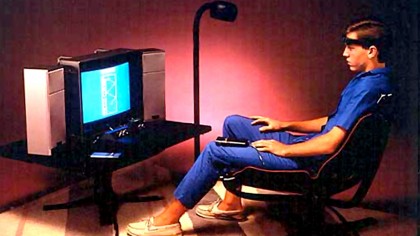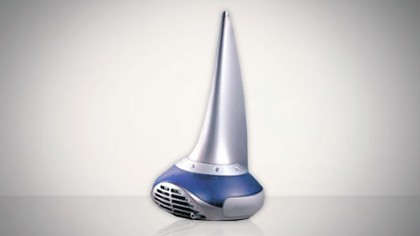What ever happened to...? 10 cool bits of tech that disappeared
Surface on a table, anyone?
6. Microsoft Surface, the one that was a table

Before the Microsoft Surface tablets there was a different Surface from Microsoft. It was massive, and trying to use one on your lap would make a good premise for an episode of some melodramatic medical drama.
It weighed 88.9kg and was a 30-inch touchscreen computer, in the years before everyone and their four year-old cousin had a tablet. It all seemed a bit Minority Report back in 2008 when it was released. For a bit of context, that was before the first Android phone was even available. Oh how different things were back then!
So what happened? Why is my dining table still unresponsive to my multi-touch gestures?
The Surface 1.0 was actually followed-up by the Samsung SUR40 in 2011, but by then the name had been changed to PixelSense. Is Microsoft just waiting for the right moment to release the 50-inch Surface tablet? Err, probably not, no.
The first Surface was, and its successor is, more of a demonstration tool than something normal people are meant to buy. It wasn't so much a demo of the future as a prop from a sci-fi marketing video.
Original Surface tables have the same sort of rarity cred as one of those old pac-man table machines these days. They're totes retro. But you can actually still buy the newer Samsung SUR40 model, for a cool £5k brand new.
Will it be back? The Microsoft Surface never really went away, it was just that we normal folk were never really the audience for the Surface 1.0. It's something to use in commercial presentations, to make us go "ooh" while looking at an animated bar chart in a Powerpoint presentation. That the current 40-inch 'Surface' model is lower-res than an iPad mini takes the shine off a bit, though. The future quickly becomes the past these days.
Sign up for breaking news, reviews, opinion, top tech deals, and more.
7. Atari Mindlink

Back in the 80s the future seemed so open. Video games in the home were still new, toddlers didn't have iPhones and home computers were fresh. And ridiculously expensive. The first Mac desktop was released in 1984, and cost about as much as a Mac Pro does today.
Also announced in the 1980s was the Atari Mindlink. It was a headband you'd wear to control computer games.
Like so many tech oddities, it was shown off at the CES tech show, in 1983, before fading rapidly into obscurity, never to actually be released to the public. When you actually learn a bit more about how it works, it's no great surprise.
You might assume it uses your brain signals to control the game, but you actually do it with your facial muscles. Work those eyebrows. It apparently gave people headaches within minutes – like a Virtual Boy without actually any VR payoff. There are obvious applications for people who don't have use of their hands, but the Mindlink was canned before those avenues were explored.
Will it be back? Fingers crossed, the Atari Mindlink is gone for good. Given Atari has Jaguar'd itself out of the games hardware market, it seems likely. However, there are now loads of comparable projects that use your eye movements or – yep – your brainwaves to control games, or interfaces.
8. The Apple game console

"Apple has made a games console". Say this convincingly enough outside an Apple Store and you'll get a few Apple fanboys quivering with excitement. The truth is that Apple has already made a game console. It was called the Pippin, and was released back in 1995. Back in the good old days when you could count the pixels and polygons used in character models.
Unfortunately it was pretty rubbish.
Rather than taking the approach of Sony and Nintendo (this was around the launch of the PlayStation) Apple looked to get developers to license the console, putting less of the responsibility on Apple's shoulders.
The console was licensed to Bandai, which made a machine that originally cost $650 (about £405, AU$747) in the US. That was twice the price of the Sony PlayStation, three times the cost of the Nintendo 64. Ouch.
It's no wonder no-one bought one, just like the Panasonic 3DO and Philips CD-i, a few other dismal failures that those sadly waving goodbye to their youth might remember.
Will it be back? There have been rumours about an Apple game console for years. But when it happens, it'll probably be a merging of products, rather than a brand new one. A new Apple TV box with support for iOS games? It seems possible, if not on the cards quite yet.
9. DigiScent iSmell

Smell-o-vision is one of those things you might assume is a joke until you hear it's real. Yep, it actually harks back to the early-ish days of cinema, in the early 1900s. Odours would be pumped into the auditorium via the seats to heighten the experience. God only know what Braindead would 'smell' like.
Guess what? No-one really liked it.
Not so hot on the heels of that steaming turd, in 2001 a couple of entrepreneurs thought that what the world needed was a sort of at-home smell-o-vision device. It's real. They made it. And they even raised $20 million in funding to make the whole thing possible.
And, yes, it really was called the iSmell.
The problem was obvious – why would you want something you could plug into a computer over USB to synthesise smells?
From an abstract perspective, though, the DigiScent iSmell it really quite an interesting bit of tech. It stores 128 core scents, which can then be blended together to make something more specific. Or, more likely, the vague sweet scent that reminds you of a Las Vegas casino.
Will it be back? DigiScent is gone, but there are plenty of other slightly wacky projects and startups that are looking at scent synthesis technology. We can't see any of them getting anywhere, but there are things out there to research if it appeals.
10. Colour ebook readers from Mirasol

E-ink has completely dominated the ereader market. It has been around since before Android existed but, aside from the lights you get with ebook readers like the Kindle Paperwhite, the tech is still recognisable as largely the same thing.
There was once another bright hope, though. Mirasol displays offer the same sort of battery benefits you get with e-ink, they don't consume much power when just displaying content, and offer reasonable colour too.
We've seen Mirasol ereaders demonstrated a fistful of times over several years, but the one device we've seen using the screen you can actually buy is the Qualcomm Toq smartwatch, which has a one inch screen. Not going to want to read a book on that, are you?
Mirasol was always a Qualcomm project, but the company has deemed the screen tech too hard to fit into a tablet or eReader on a large scale. The planned ereader was canned in 2012, and Qualcomm pulled out of producing the Mirasol displays itself in the same year.
The plan following that was apparently to license out the tech to other companies wanting to use Mirasol. We've not seen any Mirasol readers in the last two years, though, so that doesn't seem to have panned out.
Will it be back? There are several colour e-ink-style technologies out there, including colour e-ink, funnily enough. One day, we might see a colour Kindle. One day. However, there's a way to go as the technologies we've seen all look about as washed out as a watercolour painting blasted with a pressure hose.

Andrew is a freelance journalist and has been writing and editing for some of the UK's top tech and lifestyle publications including TrustedReviews, Stuff, T3, TechRadar, Lifehacker and others.